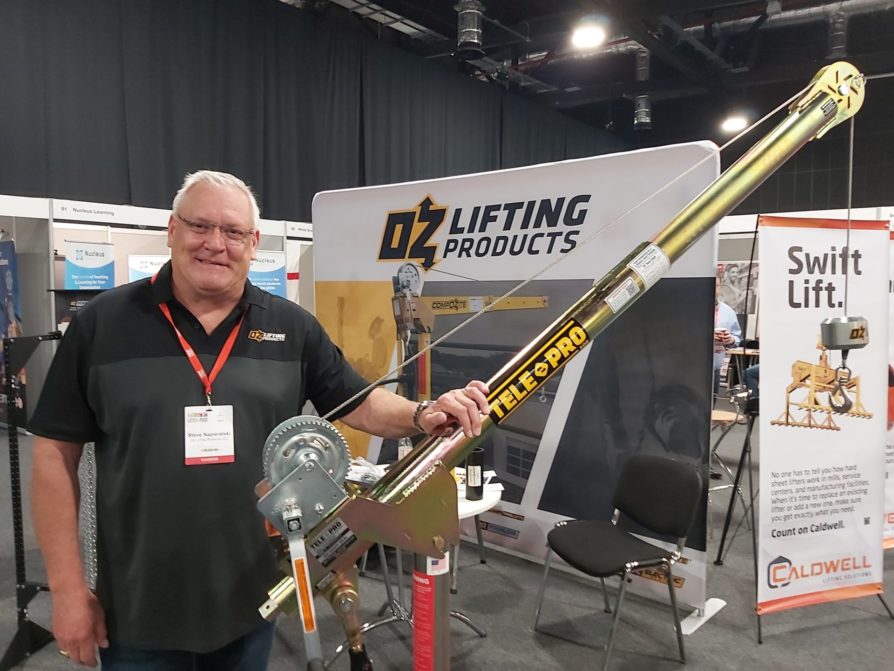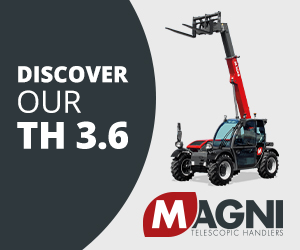)
The Only Way is Up
We must continue to train-up our growing community and upkeep the lifting products it uses, says Steve Napieralski, president at Oz Lifting.
When the Lifting Equipment Engineers Association (LEEA) launched its fifth Global Lifting Awareness Day campaign (see insert) it also pointed to skills and employment as its #GLAD2024 themes. They’re great pillars for such an event — and they got me thinking.
Our industry is high risk and needs highly skilled people employed within it. While our equipment is rented for use on a daily basis, the lifting sector is vastly different from the tool hire business and the two shouldn’t be treated as the same.
Truth is, someone mustn’t use a lever hoist just because they are smart enough to wield a hammer or axe. There are big differences. For starters, a hammer or axe have one point of contact – either a nail or a piece of wood. When using a lever hoist, the user needs to know the weight of the load and how far it needs to move. They also must know how it works. They must understand that there is a switch that allows the user to lift a load, and a neutral position to allow them to free wheel the chain for hook up and down to lower the load. And that’s only the basics.
It emphasises the necessity to raise awareness of skills and employment through #GLAD2024 and year-round campaigning. One doesn’t think of these words when they hear someone talk about buying a new hammer to fix a fence, or axe to chop firewood. Nor would maintenance and inspection spring to mind, which is why they are part of the same conversation. Specialised industries are different.
If we have trained, skilled people working in the lifting industry, they will understand the need to maintain and inspect equipment, which will create a safer environment for everyone and extend the life of products, whether they be lever hoists or larger lifting technologies.
I purposefully didn’t set this article down the pathway of one these buzzwords or topics – skills, employment, maintenance, and inspection – because they all overlap, and they all end up in the same place: we need to train-up our people and upkeep the condition of our lifting products. You could put maintenance and inspection in the same bracket, given that while inspecting, the need for maintenance is realised and minor defects are spotted before they become major problems.
SKU-whiff
The more my business has grown, the more these messages, and those shared through the #GLAD2024 movement, have become more important.
When I first started the business, we had, say, 300 stock keeping units (SKUs), and now we have almost 800. We have introduced several patented products and others that are unique to the marketplace, such as our Dyno-Hoist, a dynamometer-equipped lever hoist. Then there’s our Tele-Pro davit crane, which allows users to telescope the boom in and out under load.
We’re not a company burdened with many returned products and warranty claims, but that only tells part of the story. As I see at my firm and those I visit, the lifting sector is getting much better at packaging its goods, so we’ve never been more confident of items arriving on site in perfect condition. Additionally, we have climate-controlled storage areas to prevent rusting, and systems that stop items being damaged during storage or handling.
When distributors or end users send us photos upon delivery or at the point of use, I am only further assured. These products are all shipped with manuals and user guides and supported by safe-use content on websites in a variety of formats. It means that when damage has occurred, it is nearly always down to the way an untrained operator has been using the product.
I mean not to dwell on my company or its wares but hear me out. Every time a product is sent into the marketplace, there is potential for misuse. Surrounding every item – SKU, even – is skills, employment, maintenance, and inspection. It means that the ripple effect of my company has grown nearly three times; we’re making waves. And that’s without all the other businesses out there doing the same. Offshore, onshore, high, low, underwater, fixed, mobile, and so on; lifting equipment is ubiquitous. It means the tendency for people to misuse it endures, as is proven by the stories I hear at trade shows and the images that get circulated around via smart technology, revealing operator misuse.
Lifting champions
All of this creates an interesting cocktail. There is more equipment out there than ever before; more best practice guidance surrounding it; more people using it; and more industries celebrating how they apply lifting gear to keep them safe and productive every day.
Throw into the mix artificial intelligence (AI), automation, the Internet of Things (IoT), radio frequency identification (RFID), and Software as a Service (SaaS), and it’s a heady mix. We’re defying gravity, like we always have, but the weight on our shoulders has never been heavier, especially in terms of capacity, pace, and technology.
It’s a time to be dynamic, making sure that all boxes are ticked. At one end of the scale an end user is still operating a single workstation lifting device like their father used to many years ago; at the other, a multitude of material handling products are automated in perfect orchestra, with RFID and SaaS tracking everything, every minute of the day. This gravitation towards technology will continue. Remember, people didn’t think the mobile phone would catch on. We all know someone who would never switch to a smart device, who now has six.
Overall, I prefer to see it as an opportunity versus a challenge. Doors are opening, not closing. We remain an enticing proposition for a young person. Ross Moloney, CEO at LEEA, spoke about lifting inspectors being “heroes” recently, and I liked that. How many other industries talk about their heroes? In fact, our trained employees are all heroes – and they need to be. As I’ve said before, at every turn, safety and efficiency is in the hands of people first, technology and product second.
Remember, technology can be scary but only if we allow it to scare us. The fastest way to let it is to misunderstand it. Think about tech in terms of how it empowers people. For example, it gives campaigns like #GLAD2024 outreach to the world’s four corners, and enables us to educate, entertain, and hold to account more efficiently than ever before. We should welcome that.
#GLAD2024 momentum builds
It was great to see the fifth Global Lifting Awareness Day – #GLAD2024 – put in the diary on Thursday 18 July. The new logo looks cool too.
Powered by the Lifting Equipment Engineers Association (LEEA) and supporting organisations, it is now a widely celebrated day where manufacturers, suppliers, and end users are among those that share material that promotes safe and high quality load lifting. Social media posts, videos, articles, and in-person activity will again be bound together by the hashtag, #GLAD2024.
As I began in the main body of this article, it is interesting that LEEA has chosen skills and employment as its themes this year, and I’ve explained how I see maintenance and inspection dovetailing as well. I’d urge all stakeholders and end users to contribute by using the logo and hashtag to celebrate their involvement with the industry and promote it as an interesting place to work, with skills, employment, maintenance, and inspection all potential cornerstones of content strategies.
Celebrate the lifting industry on Thursday 18 July – include the #GLAD2024 hashtag.
AWRF, LEEA partner on accreditation
To some extent, the UK-headquartered Lifting Equipment Engineers Association (LEEA) and Associated Wire Rope Fabricators (AWRF) are seen as kindred spirits on either side of the Atlantic. They’re bigger than that, actually; LEEA, especially is a global trade organisation.
I was enthused therefore to hear that a pilot round of AWRF Accreditation Program audits has been completed, and there are plans to widen it alongside LEEA, the third-party auditors. In short, the concept is a voluntary opportunity for all AWRF member companies and their affiliated branches.
Using the current revision of the AWRF RP&G, Recommended Practice for the Operation of Sling Shops, as a basis for evaluation, LEEA will work with interested AWRF member companies to ensure compliance. The audit was developed by LEEA according to requirements set out by AWRF. Once a member company successfully completes the audit, they will then be able to market themselves as an AWRF Accredited Member, which includes the use of a logo that has recently been developed.











